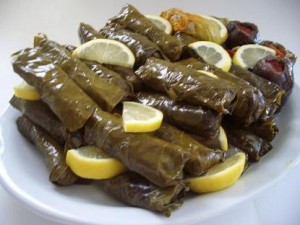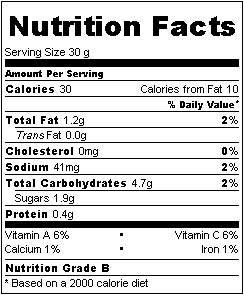Stuffed Grape Leaves with Rice & Grated Vegetables (Dolmathakia Yialantzi)
 Stuffed Grape Leaves with Rice & Grated Vegetables (Dolmathakia Yialantzi)
Stuffed Grape Leaves with Rice & Grated Vegetables (Dolmathakia Yialantzi)
In a Mexican restaurant, my husband, Gregg, will determine whether he’ll be back or not based on the taste and quality of their tamales. I do the same thing with Greek and Mediterranean restaurants and grape leaves. Grape leaves are an absolute favorite dish of mine. You can easily refrigerate any extra stuffing and use it as a side dish for another meal. The lack of meat, dairy, and eggs makes this the perfect dish for Lent or Daniel Fast. And, notice how I’ve given you yet another wonderful dish with which to use up those zucchini come August?
 |
2 jars of grape leaves in brine (16 oz. jars or about 120-150 leaves)
½ cup olive oil
1 onion
1 pound of zucchini
½ eggplant
2 medium carrots
4 ripe tomatoes
1 ½ cups of long grain rice
2 tsp Kosher salt
1 tsp freshly ground pepper
1 cup fresh parsley
juice of 3 lemons
 |
sharp knife and cutting board
large bowl
measuring cups and spoons
grater
juicer
large pot to prepare grape leaves
large bowl of ice water to cool grape leaves
large saucepan
stock pot or pressure cooker
two plates
heavy weight (or a large can of tomatoes, etc.)
 |
Finely chop the onion.
Peel the eggplant, then grate the eggplant, zucchini, and carrots.
Peel and seed the tomatoes, then finely chop.
Chop the parsley.
Juice the lemons.
Blanch the Grape Leaves
Bring 8 cups of water to a boil in a large pot, add juice of ½ lemon and 1 teaspoon salt. Carefully unroll the leaves (do not separate). Turn off the heat and place leaves in the hot water for 3 minutes. Remove leaves and place them in a bowl and cover with cold water. When cooled, drain in a colander. It is not unusual for many of the outer leaves in the jar or can to be damaged, or to tear while using. Set these aside to use later in the recipe.
 |
FILLING:
In a large saucepan, heat ½ cup of olive oil and sauté the onion for about 2-3 minutes. Add grated zucchini, eggplant, and carrots, and cook over low heat for 10 minutes. Add the tomato pulp and continue to cook for 5 minutes. Remove from the heat and set aside to cool for 15 minutes, and put in a bowl. Add the rice, parsley, remaining salt, and pepper, and mix well with a spoon until blended.
Gently separate one leaf and place it shiny side down on a work surface. Cut off the stem and discard. Place one teaspoon of the filling on the leaf at the point where the stem joined the leaf. Fold up the bottom of the leaf over the filling, then each side inward in parallel folds, and roll up the leaf. Roll should be firm, not tight, as the filling will expand during cooking. Repeat until all the filling has been used.
Cooking the Dolmathakia
Because it’s easy for the leaves to burn while the filling cooks, put a plate or wooden souvlaki skewers in the bottom of a heavy-bottomed pot. The plate should fit as closely as possible to the sides. If there are unused leaves, or leaves that were torn and not used during the filling process, put them on the plate or on top of the skewers. If you don’t have a plate that fits or skewers, line the bottom of the pan with unused or torn leaves.
Place the dolmathakia on top, packing them closely together (not squashed), seam side down, so they don’t unroll during cooking. Layer them until all are in the pot (2-3 layers is best, but no more than 4 layers). Place several unused leaves over the top.
Take another plate and place it upside down on top of the dolmathakia, with something to weight it down (a large unopened can of stewed tomatoes works nicely). Add 2 cups of water to the pot and cover.
Bring the water to a gentle boil, add the remaining lemon juice, reduce heat to low and simmer for approximately 50-70 minutes. Check to see if done. If the rice has cooked, they are done. If not, continue cooking for another 10 minutes and check again. Cooking time depends both on the type of pot used and the particular stovetop element.
If preferred, use a pressure cooker. No plates needed, but do use the skewers in the bottom. Pack the dolmathakia into the pressure cooker, add the 2 cups of water, close and cook for 15-20 minutes at the first pressure mark.
 |
About 100 pieces
Individual servings of dolmathakia are 4-5 pieces on small plates as an appetizer, however they can also be used as a side or main dish. Serve dolmathakia warm or at room temperature with avgolemono (egg and lemon sauce), lemon wedges, tzatziki, or unflavored yogurt on the side.
 |
~*~ | |
| Very high in vitamin A Very high in vitamin C High in manganese No cholesterol |
 |
|
| ~*~ | ||
 |
In Greek: ντολμαδάκια γιαλαντζί, pronounce dohl-mah-THAHK-yah yah-lahnd-ZEE
These will keep well in the refrigerator for about 5 days. Return to room temperature before serving. Drizzle olive oil on top and cover to store. They can also be frozen. If you do freeze, reheat in the microwave or by steaming and serve warm. Don’t just thaw and eat.
I would love to hear any feedback about this recipe. Did you make it? Did you enjoy it? Did you make any adjustments to it?
Hallee
I’m so grateful for your visit, today.
You would bless me if you added me to your ![]() feed reader or subscribed
feed reader or subscribed  via email.
via email.
You can also become a fan on ![]() Facebook or follow me on
Facebook or follow me on ![]() Twitter. I would love to see more of you!
Twitter. I would love to see more of you!


I have never tried stuffed grape leaves, but I’ve heard great things about them. Yours look yummy!
Thank you for dropping by my blog!